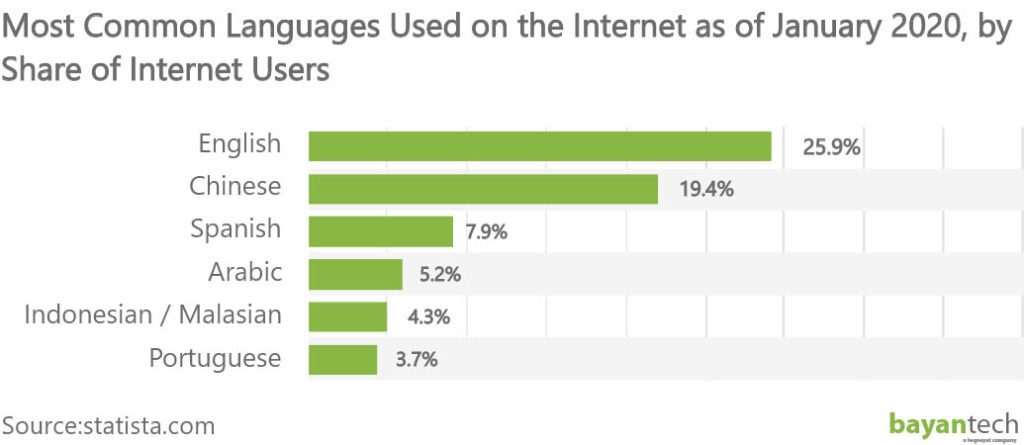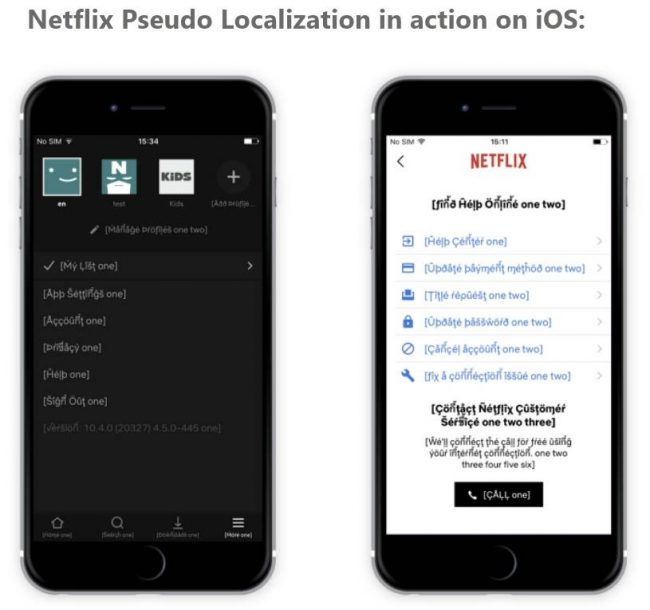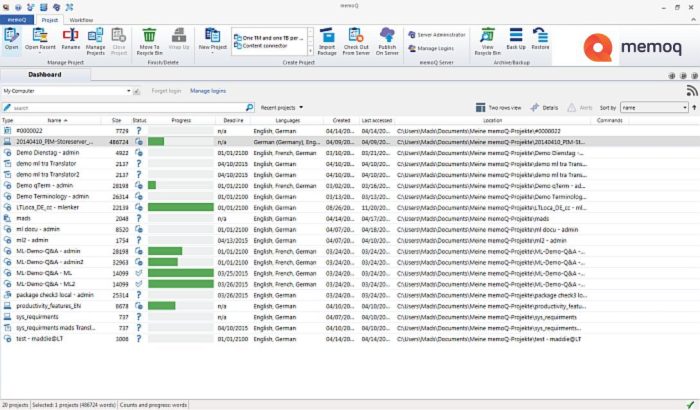Several studies conducted through the last few years have found that most users will ignore a product or service if it’s not available in their native language.
In the increasingly competitive digital markets, you can potentially grow your client base beyond your home country’s bordears. But you can’t access international growth opportunities if you don’t speak to your customers in their language. And, is there a better place to start rethinking your digital marketing than your website? That’s how website localization enters the picture.
In this post, we’ll be taking a look at why localized web pages help companies and brands grow exponentially and some of the secrets to an efficient website localization workflow.
Let’s start with: What is localization? What does it entail? What is it for?
- 1- The Basics of Localization
- 2- Why Is Web Localization Necessary?
- 3- The Preliminary Stages of the Website Localization Process
- 4- Knowing the Target Market Is Crucial in Website Localization
- 5- The Role of SEO & Keyword Research
- 6- Key Steps of the Website Localization Workflow
- 7- Can Website Localization Be Automated?
- 8- The Importance of Proper Localization Tools
- 9- Can You DIY Website Localization?
- 10- Website Localization by Specialists
The Basics of Localization
The terms “localization” and “translation” are often used interchangeably. But although translation plays a key role in localization, localizing a website implicates more than just translating it into one or multiple languages.
Before we ever take a dive into website localization workflow, it’s essential to explain its goals and priorities. Localization is the process of adapting a product, platform, or piece of media so it meets the cultural, technical, and legal standards of a certain target market.
The website localization workflow is usually longer and more technically demanding than regular translation. As we’ll cover in a later section, there are clear differences between the website localization process and what we understand as the translation workflow.
For instance, here are some key aspects of your website you’ll need to adapt during the localization process:
- Currency and dates (especially in E-commerce website localization)
- Customer representations
- UI elements
- The general tone of the copy (if necessary)
- Information density

Why Is Web Localization Necessary?
Most companies that offer their products and services on digital platforms, and expect their brand to prosper on an international scale, have made peace with the idea that they’ll eventually have to invest in website localization. Only one-quarter of internet users speak English. A company that only produces content in English is severely limiting its outreach.
Even in high English proficiency countries, you can attract far more potential customers if you speak the local language. Localizing your website guarantees good outreach.

Even in high English proficiency countries, you can attract far more potential customers if you speak the local language. Localizing your website guarantees good outreach.
On the other hand, by delivering a fully localized website, you can truly leverage the power of search engines, crafting a 100% localized SEO strategy and targeting locale-specific keywords.
From this point of view, building a multilingual website is the best -if not the only- option for international growth.

The Preliminary Stages of the Website Localization Process
As you may have noticed, website localization is a complex process that will take time, money, and effort, if you want to do it right. Implementing website localization best practices requires expertise and resources.
But before handing out your website copy to a translator and seeing the effect of their intercultural expertise, there are some key steps you should take – basically, research.

Knowing the Target Market Is Crucial in Website Localization
Considering how many languages and regions the website is going to target is a great place to start. No one knows your business better than you do. Before communicating with the project manager, you should first assess your business needs as well as your online presence. The website localization process should always be the consequence of a solid business strategy.
Knowing your target audience will help you give your localization services provider the tools they need to better optimize your company website.
The main way of identifying a prosperous potential target market is to gather accurate customer behavior data from different, specific regions. Your teams should study preferences, analyze growth rates, examine your competitors, and take note of relevant cultural trends. Consequently, they should be able to create an action plan based on the customer data they’ve collected. Website localization is one more step within that plan.

The Role of SEO & Keyword Research
Another important preliminary step is keyword research for the target market. This is useful to determine the level of demand in each specific region and understand that demand. With a clear idea of user behavior, you can create localized sites that appeal to them.
Be aware that many countries don’t use Google as the standard search engine. There are cases where search engines such as Bing, Yandex, Wiki.com will be the most popular, and each one has a different approach when it comes to keyword optimization.
Additionally, you should always keep the context and culture of the target country in mind. Just because someone speaks Spanish doesn’t mean they understand different dialects from other parts of the world where they also speak Spanish. For instance, Mexican Spanish and Chilean Spanish have some differences in vocabulary and even in which grammatical structures are considered correct.
In the following sections, we’ll take a deeper look at the website localization workflow, and address one of the most interesting questions in the world of website localization services: can website localization be automatized?
Are you Planning to Localize your Website?
Our guide to website localization is the ideal tool for you.
It includes key definitions and questions you’ll want to ask
your services provider, and it’s absolutely free.
Key Steps of the Website Localization Workflow
Before adapting your website to a specific market through localization, your language services provider should internationalize it. This process involves conducting a global elements assessment, understanding the pillars of your brand image and of the UX, and creating a culturally neutral foundation upon which they can create locale-specific versions of your site.
After the aforementioned preliminary stages (market research, keyword research, and internationalization), a proper website localization workflow can begin.

This workflow usually has 6 stages, before publishing:
Let’s take a closer look.
The first step is content extraction. It involves separating the content from the code, creating an inventory of all the content at hand, and building an appropriate glossary.
Pseudolocalization should come next. In this step, the developers use placeholder text to evaluate whether the interface can adapt to content that differs from the original in length and writing system.

Translation and cross-cultural adaptation is the next step of the process. It’s the core of the website localization workflow. Depending on the characteristics of the original website, the process may involve subtitle creators, designers, and other professionals.
Linguistic QA (quality assurance) and localization engineering will follow. Linguistic QA will ensure that the material meets quality standards and serves its purpose. Once the content has been approved, localization engineers will adapt the website to technical and usability requirements and integrate the content. The result should be a functional and market-ready website. But it’s rare to get it right the first time. That’s why the next step is crucial.
Localization testing means ensuring that your website guarantees a top-notch user experience in all aspects. That the copy is well-written and optimized, that no functionality has been affected by the tweaking of the source code, and that the website looks stunning across devices, among other aspects.
At this stage, implementing cutting-edge website localization software and automated QA tools can reduce technical issues to a minimum and streamline the entire technical deployment process.

Can Website Localization Be Automated?
It’s worth clarifying that localization and translation processes cannot be fully automated. This is pretty self-evident when you take a look at the website localization workflow, step-by-step.
As of today, there is no machine translation solution that can detect culturally inappropriate images or clumsy UI elements and replace them with carefully designed alternatives.
Localization requires a degree of cultural awareness that artificial neural networks are yet to achieve.
But, what about translation? Can the translation step alone be fully automated? It’s not odd for machine translation solutions to be unable to tell which words belong to the proper nouns. AI also tends to make transliterations that don’t match with the targeted language. These solutions also fail to find equivalent metaphors or sayings, if they were not included in their training documentation. This makes machine translation poor translators of complex or extravagant prose styles.
Language and communication are an undeniable complicated and intricate field, and the smallest mistranslation can cause problems. So you don’t want to risk it.
Sign up to our newsletter to receive the latest blogs and news.
The Importance of Proper Localization Tools
Translation management platforms or translation management systems (TMS) are real game-changers that smooth out and automate many steps in localization projects. Here are some key aspects to look for in your TMS:
- An API that connects the platform to the website’s development build. This is key to localization workflow optimization. Your developers will appreciate it.
- Collaborative functions that allow you to communicate effectively with your colleagues.
- A translation memory that provides a consistent glossary when dealing with complex words and phrases.
- Direct website translation and other functionalities that help you visualize the part of the content you’re working with.

The strategic automation of repetitive tasks can guarantee a high website localization ROI, ensuring that your localization team can make the most of their billable hours. No time wasted on doing heavy lifting. These types of functions are usually integrated into your website localization workflow through an API, code repository integrations, or webhooks.
A TMS also helps avoid fragmentation of data in the translation and localization of a website, through its project management and administration functions. A TMS will track the translation progress while monitoring the website localization workflow, creating and assigning multiple tasks to translators, developers, and designers, as well as identifying bottlenecks or missed deadlines.

Computer-Assisted Translation tools (CAT) are also an incredibly important part of an effective website localization workflow stack. They will help you build a glossary of industry or company-specific terms, ensuring that these specific words are always translated accurately. CAT tools will also provide you with translation memory, a database of every segment and text that the translator can automatically reuse. Another feature of CAT is allowing you to use machine translation, which will automatically translate texts.
Having a translation memory and an updated glossary ensures consistent and precise terminology handling. With automatically managed translation memories, even if the translations are done by different people, industry terms and common terminology will be translated exactly the same.
These types of tools also tend to automatically notify you when an error in a translation is detected: double spaces, grammar mistakes, missing placeholders, etc. This functionality can help proofreaders, editors, testers, and project managers to focus their attention on more important details during the QA stages.

Can You DIY Website Localization?
At this point, you already know that you should allocate part of your global marketing budget to website localization. And you may be thinking that the best option to conduct a smooth and cost-efficient website localization workflow is to delegate it to professionals in the field.
Certainly, looking for a reliable translation and localization company that can provide you with high-quality translation services is often the most effective solution.
A trustworthy agency will make the most profound research of the targeted markets and provide you with native-language-speaking translators who have deep knowledge and understanding of the local language. They will always know what approaches are the best option. For example, if a website translation proxy is the way to go, they will know it at first sight and will start working on it instantly.
Besides, hiring the same agency to conduct multiple localization processes will save you time and money, since an organized website localization workflow will be established, standardizing each part of the process and managing to work systematically.
When the job becomes considerably large, another possible option is to involve translation software, which allows you to rely on useful tools such as machine translation, spell-checking, word-processing, and translation memory. This will greatly reduce repetitive processes, such as creating a glossary of specific local terminology and keeping it up to date or archive the translated content.

Website Localization by Specialists
So far, we’ve noticed website localization can’t be a weekend side project. Doing it the way it has to be done requires considerable time and resources. But you don’t have to face your website localization project alone.
At bayantech, we have almost two decades leading and executing efficient website localization processes for leading brands. We’ve worked with big names in the E-commerce industry and beyond, connecting them with new customers worldwide.
Our website localization workflow is the product of multicultural expertise, cutting-edge translation tools, and strict, world-class quality assurance practices.









